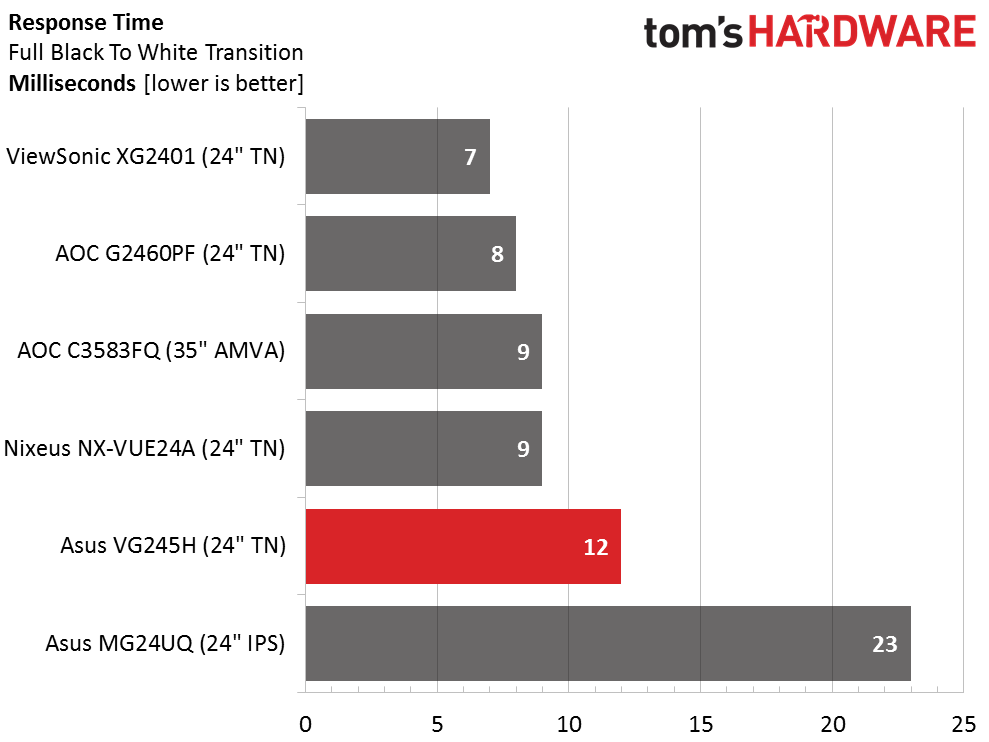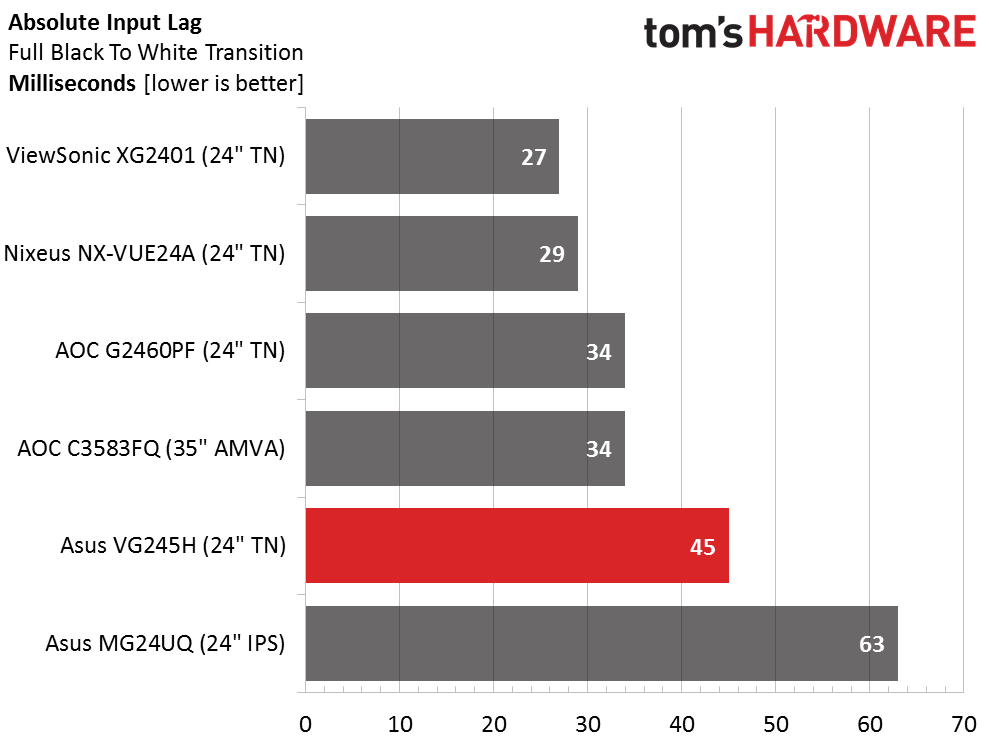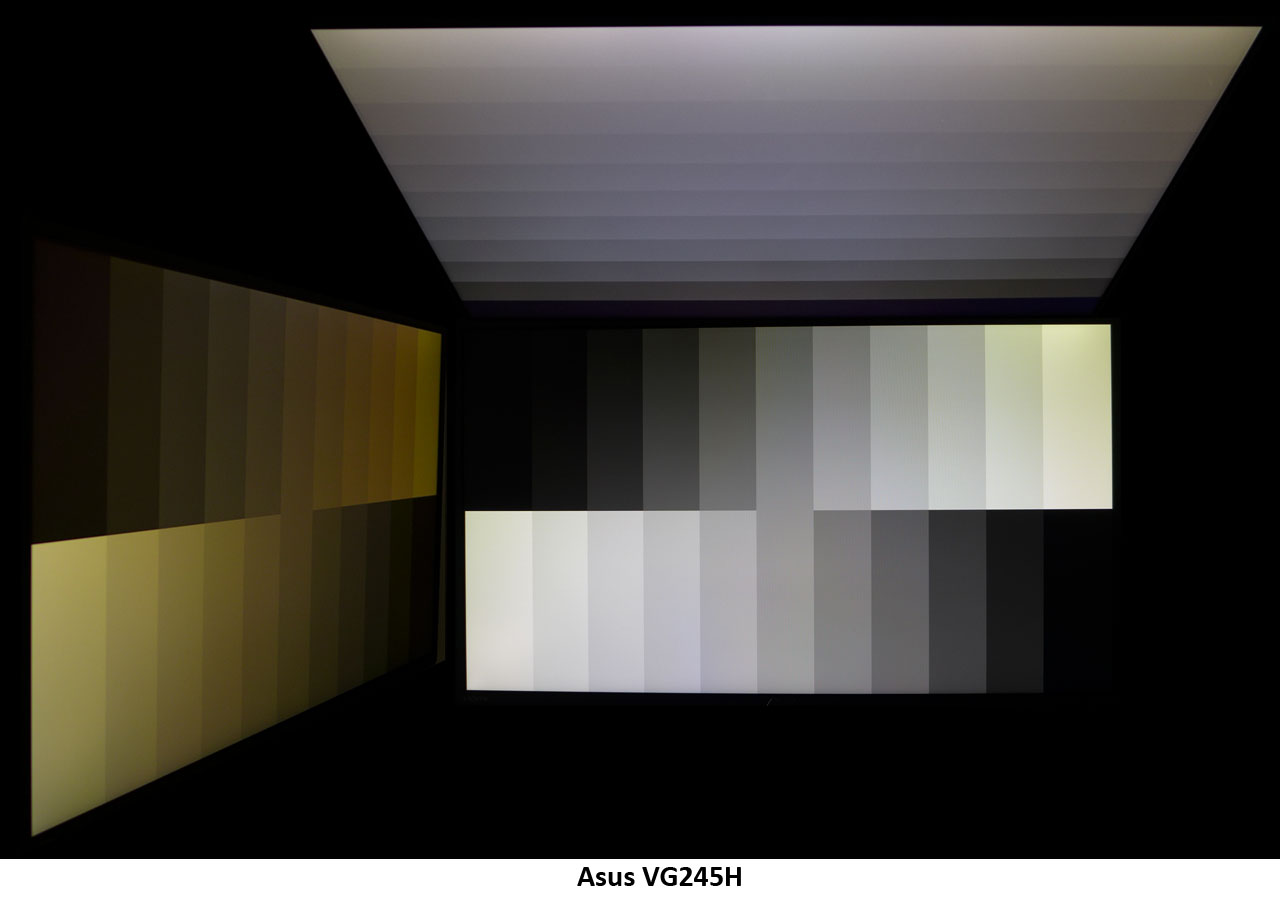Asus VG245H 24-inch FreeSync Gaming Monitor Review
Why you can trust Tom's Hardware
Viewing Angles, Uniformity, Response & Lag
To learn how we measure screen uniformity, please click here.
If viewing angles are important to you, TN is not the best choice. At the 24" size, it’s not really a factor on the desktop for a single user, however. Our photos of the VG245H are typical of the technology. To the sides you can see a red/green shift and a significant light fall off. From the top, detail is reduced but you can still see all the brightness steps. And the shift in color there is pretty minor. The takeaway is that you need to use a little extra care to place the panel precisely in front of you and angled toward the eye. But once this is accomplished, there is no penalty in image quality.
Screen Uniformity
Our VG245H sample displayed excellent screen uniformity in all three tests. As we noted in the ANSI test, there is a slight rise in black levels down the right side, but all other areas are perfect to the naked eye. In the white field test, there is a center hotspot, but again, it can’t be seen. Color uniformity is among the best we’ve measured from any monitor in our database. Considering the price point, this is mighty impressive.
Pixel Response & Input Lag
Please click here to read up on our pixel response and input lag testing procedures.


It’s pretty easy to spot the 144Hz screens here. With only 75Hz to offer, the VG245H gives up a little speed to the others. Is it something you’ll notice? Doubtful, unless you are a highly-skilled professional gamer. Even then, we don’t expect an 11ms difference in lag to be a factor. Remember that this monitor sells for under $200, which is less than the other screens here and less than nearly every 24" adaptive-sync display we’re aware of. This level of performance is more than adequate for just about everyone.
Gaming With FreeSync
After spending time with the 180Hz PG248Q, we could easily spot the drop to 75Hz. But that doesn’t mean we didn’t enjoy playing games on the VG245H. Like every other FHD screen we’ve reviewed, it takes only modest video card power to take framerates to 75 even when games are set to their highest detail levels.
While a faster monitor may spoil you, this one will still have no trouble keeping play above 40 FPS unless you have an older graphics board. Our Radeon R9 285 is getting a little long in the tooth, but it still provides an excellent experience at this resolution. Far Cry 4 on Ultra detail maintained rates over 50 FPS and occasionally hit 75. Tomb Raider was also very playable on Ultimate detail and kept speeds solidly above 60 FPS even during the most intense moments.
Get Tom's Hardware's best news and in-depth reviews, straight to your inbox.
At these refresh levels, Trace Free is a factor and its effects can be easily seen. Maxing the slider produces obvious ghosting and object trails both dark and light depending on content. The default setting is 60, which eliminates artifacts but introduces too much blur. 80 turns out to be the ideal setting, which balances both issues to an almost-invisible point.
Current page: Viewing Angles, Uniformity, Response & Lag
Prev Page Grayscale, Gamma & Color Next Page Conclusion
Christian Eberle is a Contributing Editor for Tom's Hardware US. He's a veteran reviewer of A/V equipment, specializing in monitors. Christian began his obsession with tech when he built his first PC in 1991, a 286 running DOS 3.0 at a blazing 12MHz. In 2006, he undertook training from the Imaging Science Foundation in video calibration and testing and thus started a passion for precise imaging that persists to this day. He is also a professional musician with a degree from the New England Conservatory as a classical bassoonist which he used to good effect as a performer with the West Point Army Band from 1987 to 2013. He enjoys watching movies and listening to high-end audio in his custom-built home theater and can be seen riding trails near his home on a race-ready ICE VTX recumbent trike. Christian enjoys the endless summer in Florida where he lives with his wife and Chihuahua and plays with orchestras around the state.
-
ohim 75Hz should not have the "Gaming" Tag next to the product, this is Office class hardware territory, even with the FreeSync tech. I have 60Hz FreeSync monitor and i`m alwasy outside the range of Freesync.Reply -
-Fran- I was wondering... Is there a chance for Toms to include Monitor OC? I have a feeling this monitor, as it is out of the box, is not telling the whole story...Reply
In any case, thanks for the review. For the price, it doesn't appeal to me, TBH. Not even for mundane tasks/use.
Cheers! -
newton75x it is nice and everything but 75hz is a deal breaker for a gamer even in a low budget .Reply -
Michael_498 @Ohim: This is a nice sentence. One says it, the others copy it. Like in School. But let's think about it (which is different from School). If we synchronize the whole line from game over graphics Card to, finally, the Screen, we don't Need really more than 50-60 Hz because we cannot recognize it. More is only needed without Synchronisation, if it works the way I mentioned, which is still a long way to go for the industry. So be careful with your claims, especially with "even with G-Sync".Reply -
ohim Reply19027733 said:@Ohim: This is a nice sentence. One says it, the others copy it. Like in School. But let's think about it (which is different from School). If we synchronize the whole line from game over graphics Card to, finally, the Screen, we don't Need really more than 50-60 Hz because we cannot recognize it. More is only needed without Synchronisation, if it works the way I mentioned, which is still a long way to go for the industry. So be careful with your claims, especially with "even with G-Sync".
I know what i`m talking about since i own a product as such, do you ? I`m gaming on a 3440x1440 34" LG monitor with freesync in the range of 40 to 60. In games like Battlefield 1 at Ultra i have the game sitting in that range and it is ok, but every other game will be way outside this range and thus making the FreeSync useless, Gsync at 60 Hz is just as useless.
You might say turn v-sync on and/or cap frames at 60, that`s a no go, unnecessary input lag induced for the joy of smooth frames. If you play games competitively (you do call yourself a gamer and buy a gaming product) then you want as much FPS as you can get for fast reactions. Some might say what`s the point of 150 FPS if you have a 60 Hz monitor, it is all about input and reactions and it helps, so if you come with a 60Hz/75Hz monitor and call it a "gaming" monitor i will laugh in your face.
Manufacturers are milking the hell out of the "gaming" tag, at this point this monitor has nothing special about it, it`s a TN 24" monitor with added Freesync (this costs almost nothing to implement) so why ask 200$ for a monitor that is normally 100-150$ and doesn`t have anything to do with gaming ? -
Verrin I think the value here is fantastic, with FreeSync. I can understand that most people reading this are enthusiasts with bigger budgets and higher standards, but outside of this readership I don't think most people want to spend more than 150-200 dollars on a monitor.Reply -
-Fran- Reply19028432 said:I think the value here is fantastic, with FreeSync. I can understand that most people reading this are enthusiasts with bigger budgets and higher standards, but outside of this readership I don't think most people want to spend more than 150-200 dollars on a monitor.
And why would an enthusiast with a lesser budget want a Freesync monitor?
For that price you're 100 times better off with a non-Freesync 120Hz TN monitor like this:
https://www.amazon.com/Acer-GN246HL-Bbid-24-Inch-Display/dp/B00KO4518I/ref=sr_1_3?ie=UTF8&qid=1482255634&sr=8-3&keywords=120hz+monitor
Cheers!
